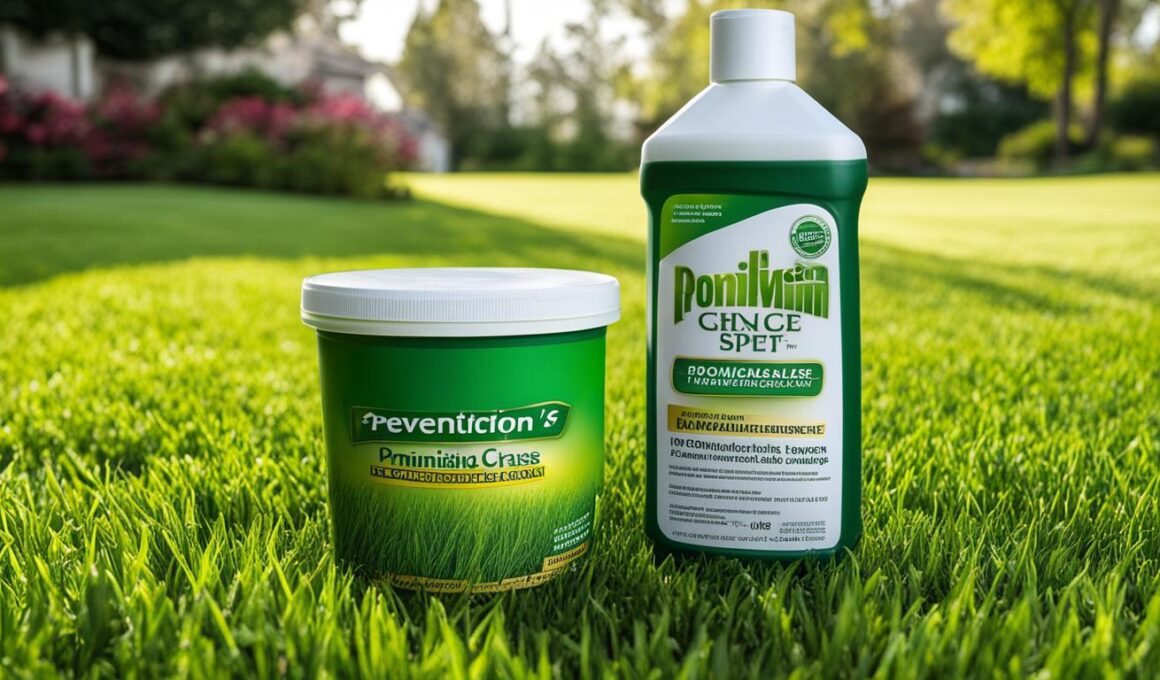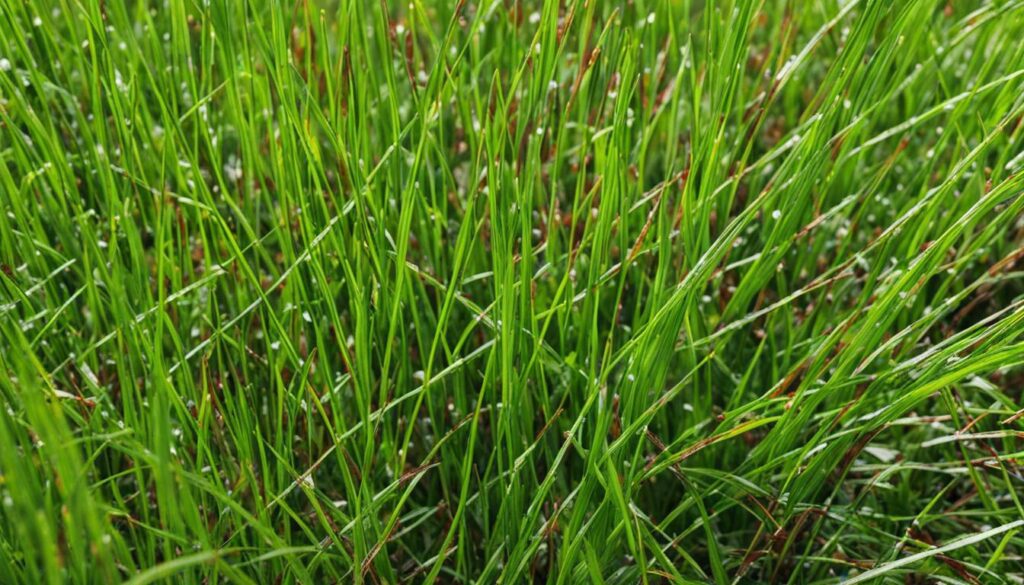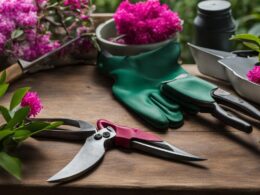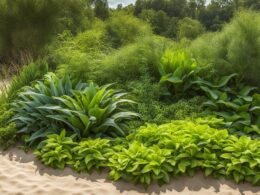Lawn dollar spot can be a frustrating problem for homeowners, causing unsightly silver-dollar-sized spots of dead turfgrass on your once lush and green lawn. To prevent this lawn disease and keep your yard healthy, it’s important to understand the causes and implement effective prevention and care strategies. By following a few simple steps, you can conquer lawn dollar spot and maintain a beautiful, disease-free lawn.
Key Takeaways:
- Maintain a proper lawn care routine to prevent and treat dollar spot
- Aerate the soil, apply compost, and control grubs to promote a healthy lawn
- Dethatch, fertilize, and irrigate properly to maintain nutrient balance
- Mow regularly and at the correct height, and mulch with grass clippings
- Overseed with disease-resistant grass cultivars and remove weeds and debris
Identifying Dollar Spot on Your Lawn
Dollar spot can be easily identified by the presence of silver-dollar-sized spots of dead turfgrass on your lawn. These spots may vary in size but are typically around the size of a silver dollar. When examining the grass blades closely, you will notice distinctive patterns. The lesions have hourglass shapes, with bleached centers and reddish-brown to purplish borders.
Another key characteristic of dollar spot is the presence of a cobweb-like coating called mycelium. The mycelium appears as a silvery coating on the affected areas. To spot the mycelium, it is best to inspect your lawn in the morning when there is dew present on the grass. The moisture helps make the mycelium more visible.
Identifying dollar spot accurately is crucial for taking the appropriate action to treat and prevent its spread. By recognizing the distinctive symptoms of dollar spot, you can implement the necessary measures to protect your lawn and maintain its health and vitality.
Preventive Measures for Dollar Spot
Proper lawn maintenance is essential in preventing dollar spot and other lawn diseases. By incorporating regular yard maintenance routines into your lawn care regimen, you can keep your grass healthy and resistant to diseases. Here are some preventive measures to help you prevent dollar spot:
- Aerate the soil: Aerating the soil relieves compaction and promotes better root growth. This allows the grass to better withstand diseases like dollar spot.
- Apply compost: Applying compost to your lawn increases the population of beneficial soil microorganisms, which help suppress the growth of dollar spot-causing pathogens.
- Control grubs: Grubs can weaken the turfgrass, making it more susceptible to dollar spot. Implement proper grub control measures to prevent their damage.
- Dethatch the lawn: Removing excess thatch, the layer of dead plant material, helps prevent dollar spot by reducing the habitat for disease-causing pathogens.
- Maintain nutrient balance: Fertilize your lawn to ensure it receives the necessary nutrients for healthy growth. A well-nourished lawn is less vulnerable to diseases.
- Irrigate properly: Deep, infrequent watering encourages deep root growth and minimizes the risk of disease. Avoid overwatering, as it can create favorable conditions for dollar spot.
- Mow regularly and at the correct height: Maintain proper mowing practices, cutting the grass to the recommended height. This helps maintain a dense turf and reduces the likelihood of dollar spot development.
- Mulch with grass clippings: Mulching your lawn with grass clippings helps retain moisture, provides nutrients to the soil, and suppresses the growth of dollar spot pathogens.
- Overseed with disease-resistant cultivars: Introduce disease-resistant grass cultivars through overseeding to enhance your lawn’s ability to resist dollar spot.
- Remove weeds and debris: Weeds and debris can harbor fungal diseases, including dollar spot. Regularly remove them to prevent disease spread.
While using fungicides can be an option for treating dollar spot, they should be combined with these preventive measures. Fungicides alone are not a reliable solution for long-term disease prevention. By following these preventive measures as part of your lawn maintenance routine, you can significantly reduce the risk of dollar spot and enjoy a healthy, vibrant lawn.
Environmental Factors That Encourage Dollar Spot Growth
Several environmental factors can encourage the growth of dollar spot on your lawn. The disease thrives in lawns with low nitrogen levels, low mowing heights, and dry soils. Dollar spot symptoms typically occur in late spring to early summer when temperatures range between 60 and 90 degrees.
The pathogen also favors warm days, cool nights, and heavy dew formation, which provides the ideal conditions for its development. Additionally, high humidity and long periods of leaf wetness, about 10 to 12 hours, create a favorable environment for dollar spot. Excessive thatch and leaving wet autumn leaves on the lawn can also encourage the growth of dollar spot.
Grass Types Vulnerable to Dollar Spots
Unfortunately, all species of both warm-season and cool-season grasses are susceptible to dollar spot. Whether you have warm-season grasses like zoysiagrass or cool-season grasses like Kentucky bluegrass, your lawn is at risk of being affected by dollar spot. It is important to be aware of this vulnerability and implement proper preventive measures to protect your grass from this lawn disease.
Please note: The image above visually represents the vulnerability of different grass types to dollar spot.
Identifying and Treating Other Lawn Diseases
Apart from dollar spot, your lawn may be susceptible to other lawn diseases such as gray leaf spot, rust, powdery mildew, anthracnose, and helminthosporium diseases. Each of these diseases has its own specific symptoms and treatment requirements, so it is important to be able to identify them correctly and take appropriate action.
One common lawn disease is gray leaf spot, which predominantly affects St. Augustinegrass and ryegrass. It manifests as elongated, tan lesions on the grass blades, with darker borders that give them a “burned” appearance. Rust, on the other hand, can affect most types of grasses and appears as orange or yellowish pustules on the leaves, which can give the grass a rusty or powdery appearance.
Powdery mildew tends to appear in areas with shade or limited air movement. It presents as a white, powdery coating on the grass blades and can cause stunted growth. Anthracnose is especially severe on creeping bentgrass and is characterized by irregular, sunken lesions on the blades, which eventually lead to dieback of the affected grass. Helminthosporium diseases encompass various grass species and typically show as discolored or necrotic lesions with distinct shapes or patterns.
Understanding the symptoms of these diseases is vital in implementing the appropriate treatments. Depending on the specific disease, treatments may include cultural practices like proper watering and aeration, consistent mowing at the right height, overseeding with disease-resistant grass cultivars, and targeted fungicide applications when necessary.
Conclusion
Consistent and proper lawn care practices are essential in preventing lawn diseases like dollar spot. By implementing a comprehensive lawn maintenance routine, you can keep your grass healthy and minimize the risk of disease outbreaks.
To prevent lawn diseases, make sure to aerate the soil to improve its health and drainage. Apply compost to increase the number of beneficial microorganisms in the soil. Control grubs, as they can weaken the turfgrass. Dethatch regularly to remove organic buildup. Fertilize your lawn to maintain the right nutrient balance. Proper irrigation is crucial, as it promotes deep root growth and prevents excessive dryness or saturation. Mow your lawn regularly and at the appropriate height for your grass type. Mulching with grass clippings helps retain moisture and adds nutrients back into the soil. Consider overseeding with disease-resistant cultivars to strengthen your lawn’s resilience. Finally, remove weeds and debris that can harbor fungal diseases.
While fungicides can be used to treat lawn diseases, they should complement your preventive measures rather than be your sole solution. By being proactive and taking the necessary steps to care for your lawn, you can conquer lawn dollar spot and maintain a lush, spot-free lawn. Remember, prevention is key in lawn disease prevention and care.
Can Overseeding Without Aerating Help Prevent Lawn Dollar Spot?
Yes, lawn overseeding tips & tricks can help prevent dollar spot without aerating. This method can help thicken the turf and reduce the likelihood of dollar spot taking hold. By overseeding regularly, you can maintain a healthy and lush lawn that is more resistant to diseases like dollar spot.
FAQ
What is dollar spot?
Dollar spot is a lawn disease caused by the pathogen Clarireedia jacksonii. It appears as silver-dollar-sized spots of dead turfgrass and is characterized by hourglass-shaped lesions with bleached centers and reddish-brown to purplish borders. Other identifying features include a cobweb-like coating called mycelium.
How can I identify dollar spot on my lawn?
Dollar spot can be identified by the presence of silver-dollar-sized spots of dead turfgrass. The lesions on the grass blades have hourglass-shaped patterns with bleached centers and reddish-brown to purplish borders. Another identifying feature is the cobweb-like coating called mycelium, which has a silvery appearance. To spot the mycelium, it is best to inspect the affected areas in the morning when there is dew present.
How can I prevent dollar spot?
Proper lawn maintenance is essential in preventing dollar spot and other lawn diseases. Regular yard maintenance routines can help keep your grass healthy and resistant to diseases. Some preventive measures for dollar spot include aerating the soil, applying compost, controlling grubs, dethatching, fertilizing, irrigating properly, mowing regularly, mulching with grass clippings, overseeding, and removing weeds and debris. While fungicides can be used to treat dollar spot, they should be combined with other preventive measures as fungicides alone are not a reliable solution.
What environmental factors encourage the growth of dollar spot?
Several environmental factors can encourage the growth of dollar spot on your lawn. The disease thrives in lawns with low nitrogen levels, low mowing heights, and dry soils. Dollar spot symptoms typically occur in late spring to early summer when temperatures range between 60 and 90 degrees. The pathogen also favors warm days, cool nights, and heavy dew formation, which provides the ideal conditions for its development. Additionally, high humidity and long periods of leaf wetness create a favorable environment for dollar spot.
Are all grass types susceptible to dollar spot?
Unfortunately, all species of both warm-season and cool-season grasses are susceptible to dollar spot. Whether you have warm-season grasses like zoysiagrass or cool-season grasses like Kentucky bluegrass, your lawn is at risk of being affected by dollar spot. It is important to be aware of this vulnerability and implement proper preventive measures to protect your grass from this lawn disease.
What are other lawn diseases that can affect my lawn?
Apart from dollar spot, there are several other lawn diseases that can affect your lawn, including gray leaf spot, rust, powdery mildew, anthracnose, and helminthosporium diseases. Each of these diseases has its own specific symptoms and treatment requirements. Understanding the symptoms and implementing appropriate treatments for these diseases is crucial in maintaining a healthy and disease-free lawn.
How can I conquer lawn dollar spot and other lawn diseases?
Conquering lawn dollar spot and other lawn diseases requires consistent and proper lawn care practices. By implementing a comprehensive lawn maintenance routine, including preventive measures like aerating, applying compost, controlling grubs, dethatching, fertilizing, irrigating properly, mowing regularly, mulching, overseeding, and removing weeds and debris, you can keep your grass healthy and minimize the risk of disease outbreaks. It is important to be proactive and take preventive measures to prevent lawn diseases rather than relying solely on fungicides. With the right approach, you can conquer lawn dollar spot and maintain a lush, spot-free lawn.











